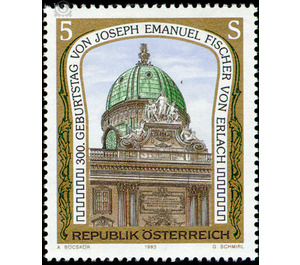300th birthday - Austria / II. Republic of Austria 1993 - 5 Shilling
Theme: Architecture
| Country | Austria / II. Republic of Austria |
| Issue Date | 1993 |
| Face Value | 5.00 |
| Color | multi-colored yellow |
| Printing Type | combination printing |
| Stamp Type | Commemorative |
| Item Type | Stamp |
| Chronological Issue Number | 1427 |
| Chronological Chapter | OOS-OE2 |
| SID | 254575 |
| In 65 Wishlists | |
Joseph Emanuel Fischer von Erlach was born on 13 September 1693 in Vienna. His father, a high court official, worked as an architectural teacher of the heir to the throne and sought-after architect of the aristocracy, created the conditions for an optimal education of his son. After studying in England and France, Joseph Emanuel 1722 returned to Vienna as a well-trained architect. A little later he entered the service of Prince Schwarzenberg and took over from his already seriously ill father, the construction management of the Schwarzenberg palaces on Rennweg and in the Kärntnerstraße. After his appointment as imperial court architect, he completed the court stables and the National Library, which had been begun by his father. The architect, who died in 1742, deserves the merit of having pioneered Classicist architecture in Austria by merging modern French design elements with the "Austrian Baroque", which was decisively influenced by his father.


